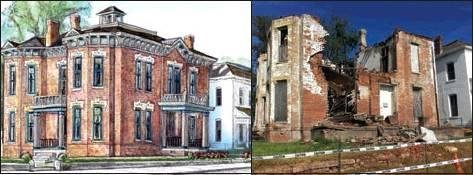The Cracker House’s sad farewell
MARK POWELL’S
HOLY COW!
HISTORY
They began tearing down the Cracker House a few days ago. It had stood at 914 Main Street in St. Joseph, Missouri, …
This item is available in full to subscribers.
Subscribe to continue reading. Already a subscriber? Sign in
Get 50% of all subscriptions for a limited time. Subscribe today.
Please log in to continueNeed an account?
|
The Cracker House’s sad farewell
MARK POWELL’S HOLY COW! HISTORY
They began tearing down the Cracker House a few days ago. It had stood at 914 Main Street in St. Joseph, Missouri, since 1873. And by month’s end it will be nothing but a pile of dusty old broken bricks.
Why does the demolition of a house you’ve never heard of, in a city more than 1,000 miles away no less, matter? Three reasons; one is personal and two pertain to everyone. First, I was born just a few blocks away and saw the Cracker House many times as a child. Next, the man who once lived in it invented something that’s probably in your kitchen pantry right now. And finally, there’s a somber message about waiting too long to save pieces of our past. Let’s begin with the pantry part.
Frank L. Sommer was among the millions of people who left this side of the Mississippi River and headed west after the Civil War. He somehow wound up in St. Joe, a roaring frontier town on the banks of the Missouri River across from Kansas. Two things are certain: he was a good businessman, because he owned a candy company and a bakery; and, as we’re about to learn, he had a sharp eye for new products.
Necessity, they say, is the mother of invention. The Oregon Trail, that famous route to the Old West’s riches, wound through St. Joe. Many pioneers started their trip there. They and other westward pilgrims had to travel light. Anything that could take up little space on the long trip was smiled upon. And Frank Sommer devised just the thing for them.
He took an old product, the traditional soda cracker, and improved it. He pressed it into a thin square, dusted it with salt, and in 1876 began mass producing it as the Premium Soda Cracker. He soon changed the named to “Saltines” after the baking salt used in them. Sommer marketed them with the strange slogan, “Polly want a cracker?” I don’t know how parrots felt, but pioneers, farmers and factory workers went crazy for Saltines. Sales quadrupled in four years. Sommers got very rich, very fast.
In 1890 his bakery merged with others to form the American Biscuit Company which, in 1898, became Nabisco. And Premium saltines are still sold in grocery stores here in South Carolina today.
Sommers used his newfound wealth to buy the stately mansion on Main Street. Locals quickly nicknamed it (what else?) the Cracker House. It was a local showplace for decades.
But times changed. The city’s “new money” eventually moved elsewhere. They built even bigger, even grander mansions along Frederick Avenue on the city’s eastern outskirts in the early 20th Century. Then the same thing began in St. Joe that happened in countless American cities: the slow decline from prosperity into poverty. The once elegant neighborhood devolved into a seedy side of town. The owner chopped the formerly grand home into cheap apartments in the 1970s. In the 80s, significant damage to the roof was neglected, allowing rain and snow to cause serious damage.
In 2012, St. Joe residents banded together to save the Cracker House. The estimated cost was frightfully high: more than $700,000. They gamely launched a fundraising campaign anyway and even made a few minor improvements to the rapidly deteriorating structure. But it was too little, too late. A rough winter and recent heavy rains finally weakened one already dangerously unstable wall to the point where it was a serious safety hazard. City officials said the Cracker House had to go.
So the wrecking crews arrived on May 10 and gingerly began tearing the old girl down. By the time you read this column, the Cracker House will be nothing but a once beautiful memory and a dream unfulfilled.
There’s a lesson here for all Americans. If you love a local historic landmark that’s at risk, you must act immediately to save it. There’s no guarantee it will still be there tomorrow. Think about that the next time you’re crumbling a Saltine into your soup.
Have comments, questions or suggestions you’d like to share with Mark? Message him at jmp.press@gmail.com.
Other items that may interest you










Comments
No comments on this item Please log in to comment by clicking here